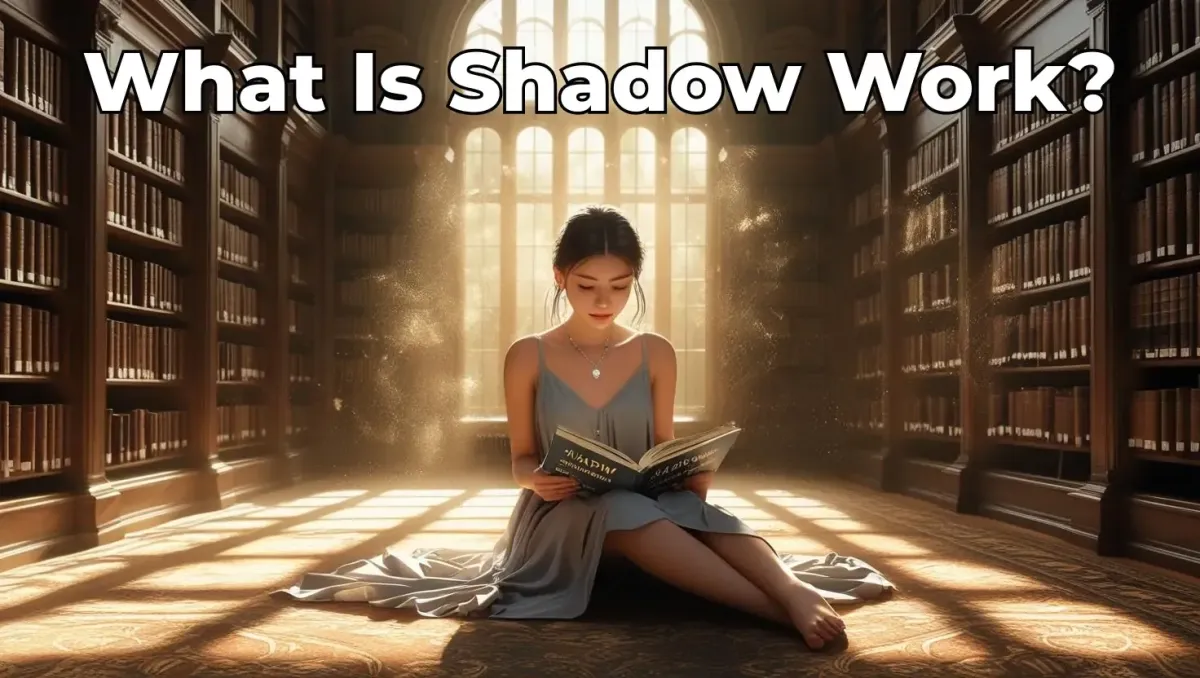Peter Paul Parker's Official Website
Articles And Guidance

Active Imagination for HSPs (Safely)
Active Imagination is Jung’s simple but profound way to meet the unconscious on purpose—through images, symbols and felt-sense dialogue. For highly sensitive people, it can be a beautiful bridge between the wisdom of dreams and the clarity of waking life. The key is safety, pacing, and embodiment. This guide gives you a gentle, step-by-step practice you can use in 12–15 minutes, plus safeguards so you never push past your window of tolerance.
If you’re brand new to shadow work, warm up with these first: What Is Shadow Work? A Complete Guide and Shadow Work for Beginners.
What Active Imagination is (and isn’t)
It’s not daydreaming. You’re consciously engaging an image, mood, or body sensation that has “charge” and letting it express itself while you respond.
It’s not analysis. You don’t decode symbols here; you relate to them. The aim is contact, not cleverness.
It’s not unbounded trance. For HSPs, we keep it brief, embodied, and timed, with strong open/close rituals.
If you enjoy ritual structure, blend ideas from Shadow Work Rituals to make sessions feel contained and meaningful.
Safety first for HSPs: the five guardrails
Short + scheduled: 12–15 minutes, max. Don’t wander.
One image at a time: Choose a single scene, symbol, or feeling. Less is more.
Body anchored: Sit upright, feet on the floor. Keep attention 50% in your body, 50% with the image.
The Stop Rule: If activation rises above 6/10 (tight chest, racing thoughts), stop, ground, and close.
Aftercare: Hydrate, stand up, shake out, breathe. If you feel stirred, do a minute of gentle movement—see Qi Gong for Emotional Healing.
If you’re in acute distress or processing big trauma, stabilisation comes first. For personalised support, consider a kind, guided space: Spiritual Guidance for Empaths and Highly Sensitive People.
Pick a starting point: image, mood, or body cue
Choose something with gentle energy (3–5/10 intensity):
A snapshot from a recent dream (locked door, roaring sea, a stranger’s face)
A repeating day image (empty chair in a meeting, a closed email tab)
A body felt-sense (tight throat when you say “no”, heavy shoulders before calls)
Capture a single headline in your journal. For structure and prompts, pair this practice with Shadow Work and Journaling.
The 12-minute Active Imagination (HSP-friendly)
0:00–1:00 — Open & ground
Sit comfortably. Name 3 things you can see, 3 you can hear, 3 you can feel on skin. Slow your breath (4-4-6 × 4 rounds).
1:00–2:00 — Set the container
Say aloud: “I’ll explore one image for ten minutes. I’ll stay kind, curious and safe. I’ll close at the bell.”
2:00–3:00 — Invite the image
Gently bring the chosen image/mood/sensation into awareness. Let it stabilise without forcing detail.
3:00–8:00 — Dialogue, don’t decode
Ask the image questions and write the replies verbatim (yes, you can “hear” them as thoughts). Helpful openers:
“Who/what are you?”
“What do you want me to know?”
“How are you trying to help me?”
“What would feel like respect right now?”
Keep answers short. If you drift or intensify, name 3 present-moment sensations and continue—or pause.
8:00–10:00 — Offer reciprocity
Thank the image. Ask: “What tiny action would honour this today?” Let it be small: a boundary sentence, a 5-minute tidy, one brave email.
10:00–11:30 — Somatic seal
Stand. Shake wrists/ankles. Roll shoulders. 4–6 slow breaths. If helpful, add 60 seconds of gentle Qi Gong flow from Qi Gong for Emotional Healing.
11:30–12:00 — Close the container
Say aloud: “Session closed. Thank you.” Visualise the image stepping behind a soft curtain that can re-open next time.
Example scripts (steal these)
When the critic appears: “I hear you want high standards. What job can I give you that helps—not hurts—me today?”
When anger shows up: “You’re energy for change. Where can I channel you safely for five minutes?”
When sadness speaks: “What do you miss? What comfort would feel respectful (not numbing) right now?”
After you listen, choose one visible micro-action for the day. Integration happens in the world, not just on the page.
For self-kindness as strengths emerge (the “golden shadow”), weave in practices from Shadow Work and Self-Love.
Making it part of your week (without overwhelm)
Twice a week is plenty. Think “training” not “searching for breakthroughs.”
Rotate inputs: One session from a dream fragment, another from a body cue.
Track themes: End each session with three words (e.g., “voice—steadiness—warmth”). Watch the arc over a month.
Pair with journalling: Short prompts from Shadow Work and Journaling keep it crisp.
Common pitfalls (and easy fixes)
Trying to be profound. Keep it ordinary and concrete. Short questions, short answers.
Overstaying. Use a timer. Leaving on time builds trust with your nervous system.
Analysing while dialoguing. Separate phases: relate first, reflect later.
Skipping aftercare. The somatic seal stops “dream residue” from clouding your day.
If a session feels too charged, switch to a stabilising day and return to gentler practices from Shadow Work for Beginners.
A short case story
Maya (44, HSP) chose the felt-sense of a tight throat before team meetings. In session, the image became a small bird in a cage. It wanted “space and warm air.” The micro-action it requested: one sentence at the start of meetings. Maya practised saying a 7-word update while standing and feeling her feet. After three weeks, the bird appeared outside the cage; the throat eased to a 2/10. Her calendar now includes a 2-minute pre-meeting grounding—small, consistent, kind.
When to seek support
You’re hitting the Stop Rule repeatedly at 6+/10.
Nightmares or intrusive images spike after sessions.
Old trauma memories begin to surface and daily function dips.
You deserve a safe, skilled container. If you’d like personalised support with pacing and integration, you can book a call here: Book a Soul Reconnection Call.
Summary
Active Imagination offers HSPs a respectful, time-boxed way to talk with the unconscious without flooding the system. Keep sessions short, choose one image, stay anchored in the body, and end with a tiny real-world action. Practised weekly, it becomes a compassionate dialogue that rewires identity—gently.
FAQs
1) Is this the same as visualisation?
Not quite. Visualisation is often goal-oriented. Active Imagination is relational—you discover what the image wants to show you.
2) How do I know I’m not “making it up”?
You are co-creating—with parts of you that hold real feelings and needs. If the dialogue leads to kinder behaviour and steadier boundaries, it’s working.
3) Can I use music or movement?
Yes—soft instrumental music and small Qi Gong movements help HSPs stay embodied. Keep volume low and movement gentle. See Qi Gong for Emotional Healing.
4) How does this relate to dreamwork?
Dreams offer raw material; Active Imagination lets you continue the conversation with a specific symbol by day. If you’re new to dreamwork, start here: Shadow Work & Dreams: A Gentle Guide (if not yet live, this will be the page you’re reading now).
5) What if nothing happens?
That’s fine. Hold the image, breathe, and ask one question. If it stays quiet, end on time and try again next week with a different entry point.
Further reading
What Is Shadow Work? A Complete Guide
Shadow Work for Beginners
Shadow Work Rituals
Shadow Work and Journaling
Shadow Work and Self-Love
Spiritual Guidance for Empaths and Highly Sensitive People
Qi Gong for Emotional Healing
I look forward to connecting with you in my next post.
Until then, be well and keep shining.
Peter. :)
Cornerstone Articles
Feeling Spiritually Lost? 🢂
Copyright Peter Paul Parker 2023 <<< ✺✺✺✺✺✺✺✺✺✺✺✺✺✺✺✺✺✺✺✺✺ >>> Terms And Conditions - >>> Privacy - Linked In - YouTube - Facebook -




